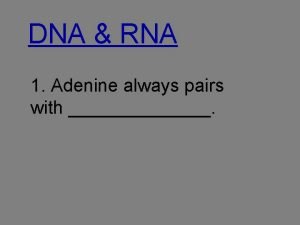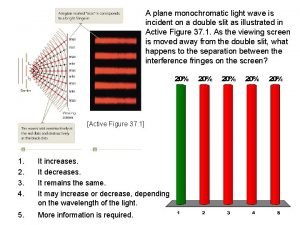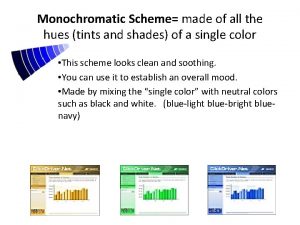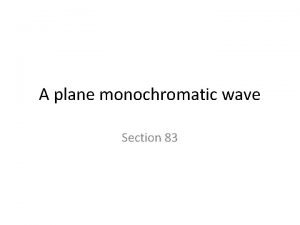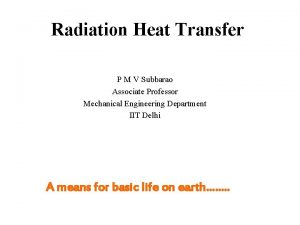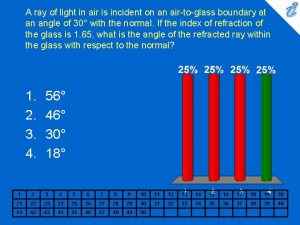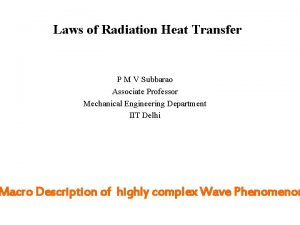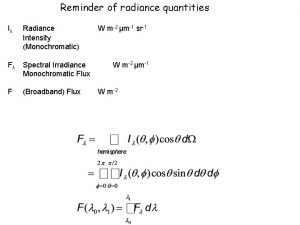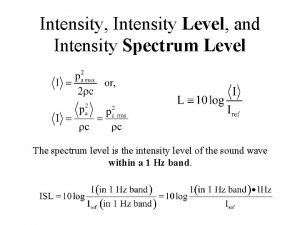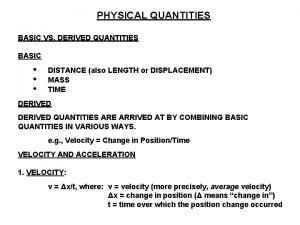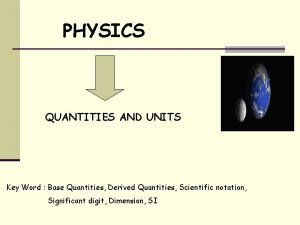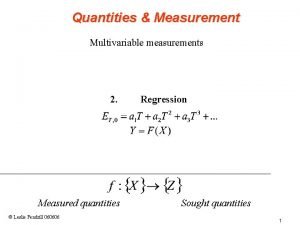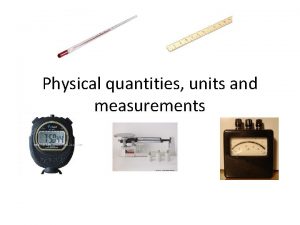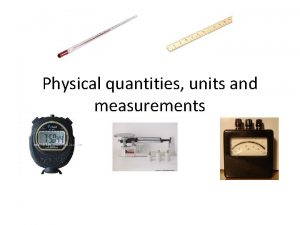Reminder of radiance quantities I Radiance Intensity Monochromatic

































- Slides: 33

Reminder of radiance quantities Iλ Radiance Intensity (Monochromatic) Fλ Spectral Irradiance Monochromatic Flux F (Broadband) Flux W m-2 μm-1 sr-1 W m-2 μm-1 W m-2

Polarization – a property of the transverse nature of EM radiationdoesn’t affect energy transfer but it is altered by the way radiation interacts with matter Simple illustration of the effects of two pieces of polarizing material (polarizers) Polarization is widely used in remote sensing: • ‘multi-parameter’ radar particle characteristics • microwave emission cloud water and precipitation • aerosol • sea-ice extent • design of instruments


Stokes Parameters – an alternate set of 4 intensity (i. e. energy based) parameters that derive directly from experiments: can be Measured!

Stokes Parameters – an alternate set of 4 intensity (i. e. energy based) parameters that derive directly from experiments: can be Measured! Total Intensity Linear polarization Linear pol at 45° Circular Polarization For a monochromatic wave: Iperp Ipar (in general)

NOTE: Measurements of polarization are actively used in remote sensing in the solar and microwave regions. Polarization in the microwave–mainly due to reflection from the surface. Polarization in the solar –reflection from the surface and scattering by molecules and particulates. Active remote sensing (e. g. , radar) commonly uses polarized radiation.

Region Spectral Range Fraction of solar output Remarks X-rays λ < 0. 01 μm Photoionizes all species; absorbed in upper atmosphere. Extreme UV 0. 01 < λ < 0. 1 μm Photoionizes O 2 and N 2 ; absorbed above 90 km Far UV 0. 1 < λ < 0. 2 μm 0. 15% Photodissociates O 2; absorbed above 50 km UV-C 0. 2 < λ < 0. 28 μm 2% Photodissociates O 2 and O 3; absorbed above 30 km UV-B 0. 28 < λ < 0. 32 μm 2% Mostly absorbed by O 3 in stratosphere; sunburn! UV-A 0. 32 < λ < 0. 4 μm 8% Reaches surface Visible 0. 4 < λ < 0. 7 μm 37% Atmosphere mostly transparent Near IR 0. 7 < λ < 4 μm 50% Partially absorbed, H 2 O, some useful RS lines (methane, CO 2, O 2) Thermal IR 4 < λ < 50 μm 1% Absorbed & emitted by wv, co 2, ozone, other trace gases Far IR 50 μm < λ < 1 mm Absorbed by water vapor Microwave 50 μm < λ < 30 cm Clouds & rain; semi transparent; o 2 & h 2 o lines Radio λ > 30 cm



Glowing wires in labs, when heated to high temperatures, Had intensity that followed a characteristic shape! Further, found that the total flux emitted (integrate over all wavelengths) depended ONLY on temperature.


Basic Laws of Emission Consider an ‘isolated cavity’ and a hypothetical radiating body within it at temperature T. An equilibrium will exist between the radiation emitted from the body and the radiation that body receives from the walls of the cavity. The ‘equilibrium’ radiation inside the cavity is determined solely by the temperature of the body. This radiation is referred to as black-body radiation. Two black-bodies of the same temperature emit precisely the same amount of radiation - proof 2 nd law

We can very closely approximate blackbody radiation by carefully constructing a cavity and observing the radiation within it.








(in units of frequency, = c/ )

Planck’s “Quantum Leap” of Faith • Max Planck discovered via hypothesis that there is a discrete number of permitted energy levels for an oscillator. • Classical physics would suggest a that there should exist a smooth continuum of possible energy values. • Planck’s Constant (h) is a proportionality constant relating the permitted energy levels to the frequency of the oscillator ( = c/ ). • The discrete energy levels can then be expressed as: E = n h Above: discrete energy levels of the hydrogen atom

Planck’s Blackbody Function The nature of B (T) was one of the great findings of the latter part of the 19 th century and led to entirely new ways of thinking about energy and matter. Insert fig 3. 1 There are 4 ‘laws’ or properties of the Planck function that have important consequences: (i) Wien displacement law; (ii) Stefan-Boltzmanm Law; (iii) Rayleigh-Jeans law and (iv) Wein radiation law

COLD SPACE – THE MOST PERFECT BLACKBODY EVER MEASURED:


Higher temperature blackbodies are higher at EVERY wavelength.

The solar spectrum is a near blackbody at 5762 K.


The sun & earth’s spectra do not overlap much! Thank goodness.

Another perspective: normalized area under BB curves

From The Climate Near the Ground (Geiger, Aron, and Todhunter)


Satellite spectrum over tropical Pacific.
 Linear and angular quantities
Linear and angular quantities Computation symbols
Computation symbols Phytel appointment reminder
Phytel appointment reminder What is ironic about dr. strauss’s reminder?
What is ironic about dr. strauss’s reminder? Adenine always pairs with *
Adenine always pairs with * Binder reminder
Binder reminder Pda language
Pda language What do you mean by advertising
What do you mean by advertising Critical reminder
Critical reminder Cohesive essay
Cohesive essay Thanks for the reminder.
Thanks for the reminder. Pda reminder 1
Pda reminder 1 I693 reminder letter
I693 reminder letter Adjectives for reminder
Adjectives for reminder Stir you up by way of reminder
Stir you up by way of reminder Sql reminder
Sql reminder Pda reminder 1
Pda reminder 1 Growth mindset crumpled paper activity
Growth mindset crumpled paper activity Monochromatic light wave
Monochromatic light wave Monochromatic refers to a painting done in one color.
Monochromatic refers to a painting done in one color. Analogous fashion
Analogous fashion Color scheme puzzle
Color scheme puzzle Colo.r
Colo.r Monochromatic analogous
Monochromatic analogous Monochromatic value
Monochromatic value Van gogh monochromatic
Van gogh monochromatic Split complementary color scheme
Split complementary color scheme Monochromatic wave
Monochromatic wave Definition of emissivity
Definition of emissivity Balance in plating
Balance in plating A ray of light in glass is incident on a boundary with air
A ray of light in glass is incident on a boundary with air Color code personality
Color code personality Monochromatic emissive power formula
Monochromatic emissive power formula Monochromatic light eg
Monochromatic light eg




